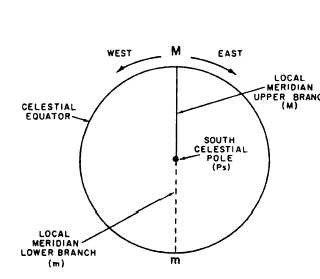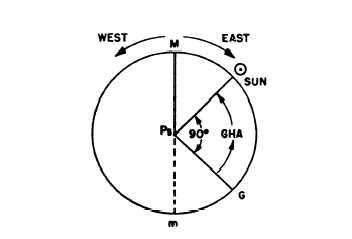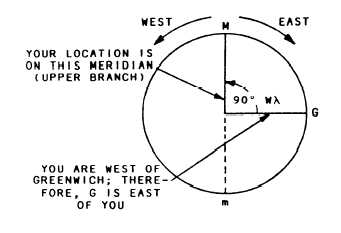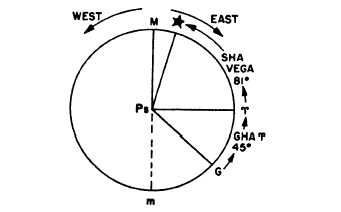Figure 15-6.-Time diagram.
Figure 15-7.-Locating G on the time diagram location at 90°
longitude.
In the time diagram (fig. 15-6), the observer is
theoretically located outside the celestial sphere, over
its south pole. The diagram consists of a circle
representing the celestial equator. The center of the
circle is the south celestial pole. Counterclockwise
direction is westerly. The local meridian is drawn in as
a vertical line, thus placing the upper branch(M), which
is the arc of a celestial meridian, between the poles at
the top of the diagram and the lower branch (m) at the
bottom. To avoid confusion, we show the lower
meridian as a dashed line.
You locate the Greenwich meridian (G) by means
of your longitude (symbol i). If you were at longitude
90°W, G would appear on your diagram 90° clockwise
from M because you are counterclockwise or west of G.
A glance at figure 15-7 will confirm this location. What
you really do, then, is measure from M toward
Greenwich, the direction depending upon whether you
are in east or west longitude.
Figure 15-8.-GHA of the sun on a time diagram.
Figure 15-9.-Locating the vernal equinox and a star on a time
diagram.
Figure 15-8 shows another time diagram on which
GHA of the sun is indicated. The upper branch of the
sun’s hour circle is shown as a solid line. The angle, or
arc, of the celestial equator between the Greenwich
meridian and the sun’s hour circle is 90°. Therefore,
GHA of the sun at this instant is 90°. Remember, GHA
is always measured westward from G.
The GHA of a star is measured in the same direction
from Greenwich to the star; however, because the SHA
enters the picture here, your method of locating a star
on the time diagram is somewhat different. First, you
must locate the vernal equinox by its tabulated GHA.
Let’s say the GHA of the vernal equinox for the time of
your observation is 45°. You locate the vernal equinox
45°W from Greenwich, as shown in figure 15-9. The
symbol that resembles a pair of ram’s horns represents
the vernal equinox.
From the Nautical Almanac you find the SHA of the
star in question. You already know that the SHA is
measured to the west from the vernal equinox (first point
of Aries). All you have to do here is find the SHA of this
star and measure the SHA westward from the vernal
15-12







